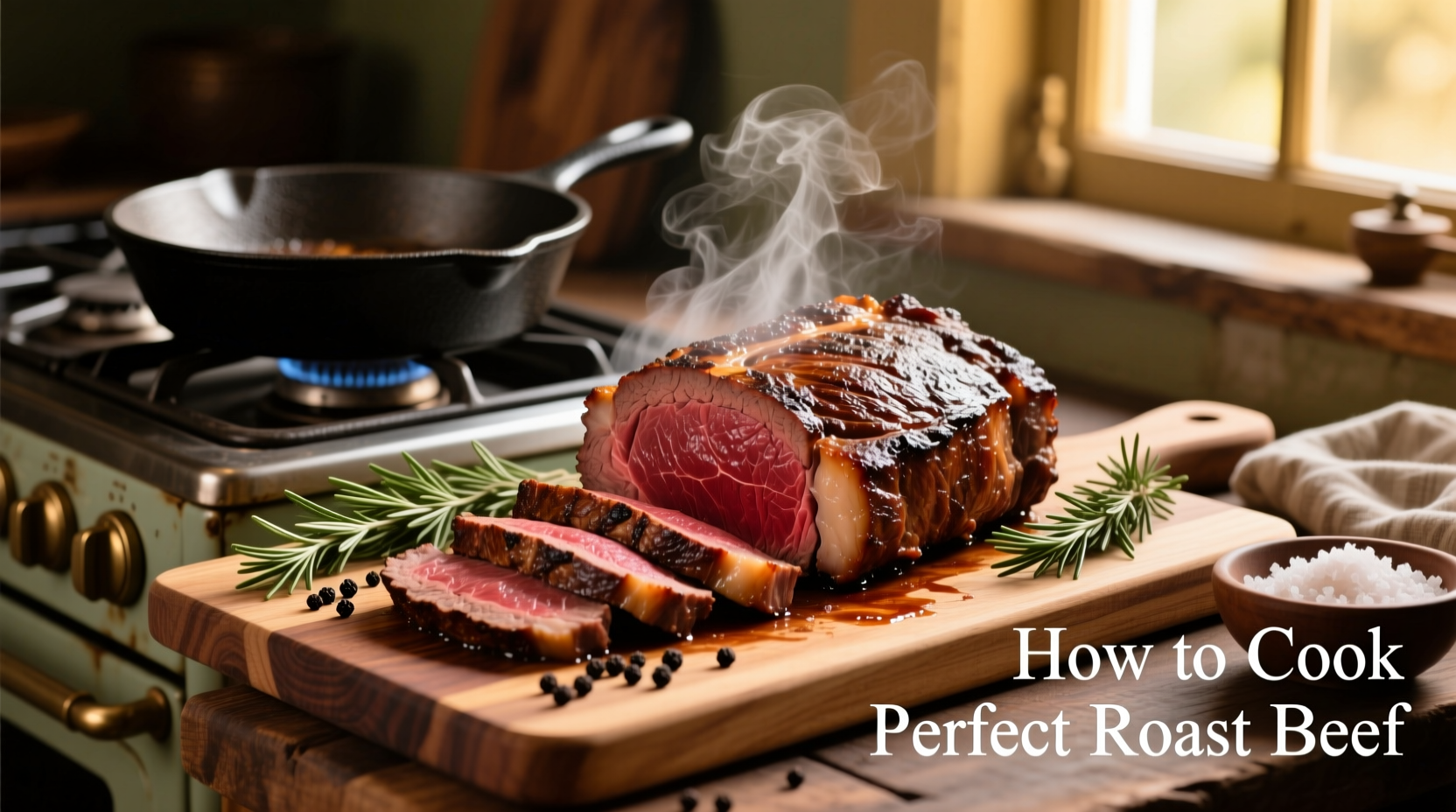Perfect roast beef starts with selecting the right cut, seasoning properly, and cooking to precise internal temperatures. For medium-rare, roast at 325°F until the internal temperature reaches 130-135°F, then rest for 15-20 minutes. This guide delivers professional techniques for tender, juicy results every time.
Nothing impresses guests or satisfies a family dinner like a perfectly cooked roast beef. Whether you're preparing Sunday dinner or hosting a holiday celebration, mastering this classic dish elevates your cooking repertoire. With 20 years of professional kitchen experience, I've refined the process to eliminate guesswork and guarantee success.
Essential Tools You'll Need
Before you begin, gather these kitchen essentials for perfect roast beef:
- Instant-read meat thermometer (critical for accuracy)
- Roasting pan with rack
- Sharp chef's knife for carving
- Meat brush for basting
- Aluminum foil for resting

Choosing Your Cut: What Works Best
Not all beef roasts behave the same in the oven. Understanding these differences prevents disappointing results:
| Cut | Best For | Cooking Time (per pound) | Flavor Profile |
|---|---|---|---|
| Ribeye (Prime Rib) | Special occasions | 15-18 minutes | Rich, buttery, well-marbled |
| Tenderloin | Elegant presentations | 20-25 minutes | Mild, lean, exceptionally tender |
| Sirloin Tip | Everyday meals | 20-22 minutes | Beefy, moderately tender |
| Round | Budget-friendly option | 25-30 minutes | Lean, benefits from slow roasting |
The USDA Food Safety and Inspection Service recommends cooking beef roasts to a minimum internal temperature of 145°F (followed by a 3-minute rest) for food safety, though many chefs prefer lower temperatures for medium-rare results. Always verify with a reliable thermometer rather than relying on time alone.
Step-by-Step Cooking Process
Preparation Timeline (24 Hours Before)
Perfect roast beef begins long before it hits the oven. Follow this professional timeline for optimal results:
- 24 hours before cooking: Remove packaging, pat dry, and place on a wire rack in the refrigerator. This dry-brining process enhances crust formation.
- 2 hours before cooking: Take roast from refrigerator to bring to room temperature. Season generously with kosher salt (1 tablespoon per 5 pounds) and freshly ground black pepper.
- 30 minutes before cooking: Add garlic powder, rosemary, and thyme. Insert thermometer probe if using.
The Roasting Process
Follow these precise steps for restaurant-quality results:
- Preheat oven to 325°F (convection setting if available)
- Place roast fat-side up on rack in roasting pan
- Insert meat thermometer into thickest part (avoiding bone)
- Roast without opening oven until thermometer approaches target temperature
- For medium-rare: Remove at 125-130°F (temperature will rise during resting)
- For medium: Remove at 135-140°F
- For well-done: Remove at 150°F (not recommended for best quality)
Resting and Carving
This critical step makes or breaks your roast:
- Transfer roast to cutting board, tent loosely with foil
- Rest for 15-20 minutes (15 for smaller roasts, 20 for larger)
- During resting, internal temperature will rise 5-10°F
- Carve against the grain using sharp knife
- Slice to 1/4-1/2 inch thickness depending on cut
Troubleshooting Common Issues
Even experienced cooks encounter these challenges. Here's how to fix them:
Dry Roast
Cause: Overcooking or insufficient resting time
Solution: Always cook to precise temperatures and never skip the resting period. For leaner cuts like round, consider barding with fat or using a marinade.
Tough Texture
Cause: Incorrect cut selection or carving with the grain
Solution: Choose appropriate cuts for roasting and always carve against the grain. For tougher cuts, try slow-roasting at 275°F for extended periods.
Pale, Unappetizing Crust
Cause: Insufficient surface drying or low oven temperature
Solution: Refrigerate uncovered before cooking and ensure oven is properly preheated. A quick sear in a hot skillet before roasting creates excellent crust development.
Serving Suggestions
Elevate your roast beef with these professional pairings:
- Classic Yorkshire Pudding: Made with the roast's drippings for authentic flavor
- Horseradish Cream: Mix 1/2 cup sour cream, 2 tbsp prepared horseradish, 1 tsp lemon juice, and fresh chives
- Vegetable Pairings: Roasted carrots with thyme, garlic mashed potatoes, or green beans almondine
- Wine Pairing: Cabernet Sauvignon or Malbec complements the rich beef flavor
For special occasions, consider presenting the roast on a heated platter with fresh herb garnish. Slice tableside for an impressive presentation that keeps the meat warm.
Advanced Techniques for Perfect Results
Take your roast beef to the next level with these professional methods:
Salt-Rub Method
Apply 1 tablespoon of kosher salt per 5 pounds of meat 24-48 hours before cooking. This dry brine tenderizes the meat and enhances flavor penetration without making it salty.
Reverse Sear Technique
For exceptionally even cooking, especially with thicker cuts:
- Place roast in 225°F oven until internal temperature reaches 115°F
- Remove, increase oven to 450°F
- Return roast to high heat for 10-15 minutes to develop crust
- Rest before carving
Temperature Reference Guide
Use this definitive guide for perfect results:
| Doneness | Internal Temperature | Appearance | Resting Time |
|---|---|---|---|
| Rare | 120-125°F | Red center, cool | 10-15 minutes |
| Medium-Rare | 130-135°F | Warm red center | 15-20 minutes |
| Medium | 140-145°F | Pink center | 15-20 minutes |
| Medium-Well | 150-155°F | Slight pink | 20 minutes |
| Well-Done | 160°F+ | Little to no pink | 20+ minutes |
Remember that temperature continues to rise 5-10 degrees during resting. Always remove the roast from the oven before reaching your target final temperature.











 浙公网安备
33010002000092号
浙公网安备
33010002000092号 浙B2-20120091-4
浙B2-20120091-4